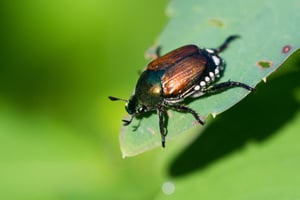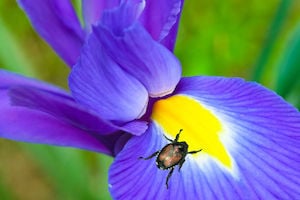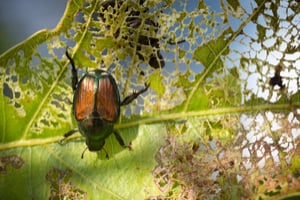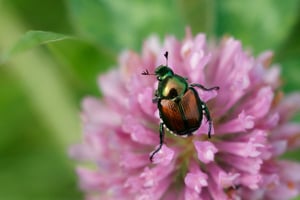Even if you don’t know what a Japanese beetle is, you probably know what they look like. The shiny green-and-bronze beetles are one of the most common--and frustrating--lawn pests in the US. Every summer, they show up in droves to feast on virtually every tree, plant, and bush they can find. They’ll even chew straight through flower bulbs! For how common and troublesome Japanese beetles are, however, most people don’t know much about them. Did you know, for instance, that Japanese beetles live most of their lives as grubs under the soil? That’s also when they’re the most destructive! Here’s everything you should know about your summer nemesis--including how to keep them from destroying your yard this year.
What are Japanese beetles?
 Japanese beetles (Popillia japonica) are an invasive beetle species distributed throughout most of the eastern and central US. Adult Japanese beetles are small (⅓-½” long), with green heads and metallic-looking, copper-colored elytra (wing covers). Their exoskeleton has a distinctively iridescent or metallic look and often catches the sunlight. Adult beetles also have six white tufts of hair sticking out from either side of their lower abdomens. Japanese beetles are a common garden pest, so you’ll frequently see adults on garden plant leaves.
Japanese beetle larva (or grubs) are sometimes called “white grubs” because of their pale, creamy orange or white coloration. Their heads and legs are darker than their torso and abdomen, which can appear almost translucent. Japanese beetle grubs are normally around one inch long. They often bend their backs and curl forward, giving them a “C-shaped” appearance. Grubs live underground until adulthood, where they can feed on root systems. Larvae may darken as they grow and feed.
Japanese beetles (Popillia japonica) are an invasive beetle species distributed throughout most of the eastern and central US. Adult Japanese beetles are small (⅓-½” long), with green heads and metallic-looking, copper-colored elytra (wing covers). Their exoskeleton has a distinctively iridescent or metallic look and often catches the sunlight. Adult beetles also have six white tufts of hair sticking out from either side of their lower abdomens. Japanese beetles are a common garden pest, so you’ll frequently see adults on garden plant leaves.
Japanese beetle larva (or grubs) are sometimes called “white grubs” because of their pale, creamy orange or white coloration. Their heads and legs are darker than their torso and abdomen, which can appear almost translucent. Japanese beetle grubs are normally around one inch long. They often bend their backs and curl forward, giving them a “C-shaped” appearance. Grubs live underground until adulthood, where they can feed on root systems. Larvae may darken as they grow and feed.
Where did Japanese beetles come from?
 You’ve probably already figured out that Japanese beetles are native to Japan. It came to the US via the shipping industry, allegedly in a shipment of iris plants. It was first discovered in a nursery in Riverton, New Jersey in 1916. Unfortunately, the predators that naturally control Japanese beetles aren’t established in the US, so the beetles could proliferate unchecked. The beetles travel throughout the US by flying and by hitching rides on plant material such as nursery stock.
Japanese beetles are present all year, but they become very active in mid summer. Adult Japanese beetles mate in June and July and lay their eggs under topsoil. A single female Japanese beetle can lay as many as 40-60 eggs at a time. The eggs hatch into grubs within weeks. Grubs spend the next 10 months burrowed in the soil, where they feed on roots and grow. Grubs begin eating more frequently the following spring, then pupate and emerge as an adult by late June. Once a Japanese beetle reaches adulthood, they only live for another 40-60 days.
You’ve probably already figured out that Japanese beetles are native to Japan. It came to the US via the shipping industry, allegedly in a shipment of iris plants. It was first discovered in a nursery in Riverton, New Jersey in 1916. Unfortunately, the predators that naturally control Japanese beetles aren’t established in the US, so the beetles could proliferate unchecked. The beetles travel throughout the US by flying and by hitching rides on plant material such as nursery stock.
Japanese beetles are present all year, but they become very active in mid summer. Adult Japanese beetles mate in June and July and lay their eggs under topsoil. A single female Japanese beetle can lay as many as 40-60 eggs at a time. The eggs hatch into grubs within weeks. Grubs spend the next 10 months burrowed in the soil, where they feed on roots and grow. Grubs begin eating more frequently the following spring, then pupate and emerge as an adult by late June. Once a Japanese beetle reaches adulthood, they only live for another 40-60 days.
Why are Japanese beetles a problem?
 Japanese beetles are considered the most important turfgrass-infesting pest in the United States. The beetle inflicts economically significant damage on lawns, crops, and gardens. They’re known to feed on over 300 different plant species. Grub and adult beetle stages do different kinds of damage. Grubs chew through grass and ornamental plant roots from underground, reducing the plant’s ability to effectively absorb water. Adults “skeletonize” the leaves of many plants by chewing away leaf tissue but leaving behind the fibrous structure.
Japanese beetles feed on a wide variety of plants, including many very common lawn and garden plants. You’ll commonly find them on linden, maple, oak, birch, elm, and willow trees, among others. They’ll also damage fruit such as apples and raspberries, vegetables such as corn and soybeans, and more. They’re considered a serious agricultural pest. Grubs can also inflict serious lawn damage by swathes of turfgrass, leaving behind yellow, dead patches.
Japanese beetles are considered the most important turfgrass-infesting pest in the United States. The beetle inflicts economically significant damage on lawns, crops, and gardens. They’re known to feed on over 300 different plant species. Grub and adult beetle stages do different kinds of damage. Grubs chew through grass and ornamental plant roots from underground, reducing the plant’s ability to effectively absorb water. Adults “skeletonize” the leaves of many plants by chewing away leaf tissue but leaving behind the fibrous structure.
Japanese beetles feed on a wide variety of plants, including many very common lawn and garden plants. You’ll commonly find them on linden, maple, oak, birch, elm, and willow trees, among others. They’ll also damage fruit such as apples and raspberries, vegetables such as corn and soybeans, and more. They’re considered a serious agricultural pest. Grubs can also inflict serious lawn damage by swathes of turfgrass, leaving behind yellow, dead patches.
How Do I Treat Japanese Beetles?
 When beetles find a food source, they secrete an aggregation pheromone that attracts more beetles. You should prevent the beetles from secreting this pheromone as much as possible. First, identify specific plants on your lawn that Japanese beetles feed on. When you find beetles, collect them by brushing them into a jar or bucket containing soapy water. You should also gently wash the surfaces beetles infested with the soapy water to remove the pheromone left behind. Repeat this process as frequently as possible. The best time to find Japanese beetles is during the early morning.
Japanese beetle eggs and grubs depend on soil moisture to survive during hot, dry summer. Japanese beetle grubs are very susceptible to drying. If you can let your first couple inches of topsoil dry out, it might considerably reduce grub damage. Some biological control measures like nematodes are commonly applied to treat Japanese beetles, but their results are inconsistent. Nematodes of the genus Heterorhabditis seem particularly effective. Milky spore (Paenibacillus popilliae) is a bacterium that induces “milky disease” in Japanese beetles without harming other insects. There is some evidence that it will help reduce Japanese beetle grub populations in the long term.
Japanese beetles are a tenacious foe. There’s a reason why they’ve managed to survive this long and spread this far. Despite their ubiquity, however, Japanese beetles are not invincible. Far from it, in fact. By understanding what makes these beetles tick and following our tips, you could see serious prevention results this summer.
If you don’t have time to wait on your results, you could also call Plunkett’s today. Our experts have the tools, expertise, and experience they need to drive out Japanese beetles fast. It’s not too late to save your lawn this summer; just call now!
When beetles find a food source, they secrete an aggregation pheromone that attracts more beetles. You should prevent the beetles from secreting this pheromone as much as possible. First, identify specific plants on your lawn that Japanese beetles feed on. When you find beetles, collect them by brushing them into a jar or bucket containing soapy water. You should also gently wash the surfaces beetles infested with the soapy water to remove the pheromone left behind. Repeat this process as frequently as possible. The best time to find Japanese beetles is during the early morning.
Japanese beetle eggs and grubs depend on soil moisture to survive during hot, dry summer. Japanese beetle grubs are very susceptible to drying. If you can let your first couple inches of topsoil dry out, it might considerably reduce grub damage. Some biological control measures like nematodes are commonly applied to treat Japanese beetles, but their results are inconsistent. Nematodes of the genus Heterorhabditis seem particularly effective. Milky spore (Paenibacillus popilliae) is a bacterium that induces “milky disease” in Japanese beetles without harming other insects. There is some evidence that it will help reduce Japanese beetle grub populations in the long term.
Japanese beetles are a tenacious foe. There’s a reason why they’ve managed to survive this long and spread this far. Despite their ubiquity, however, Japanese beetles are not invincible. Far from it, in fact. By understanding what makes these beetles tick and following our tips, you could see serious prevention results this summer.
If you don’t have time to wait on your results, you could also call Plunkett’s today. Our experts have the tools, expertise, and experience they need to drive out Japanese beetles fast. It’s not too late to save your lawn this summer; just call now!






